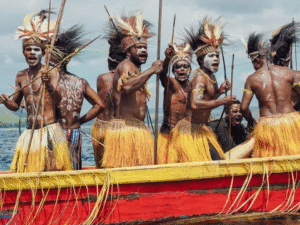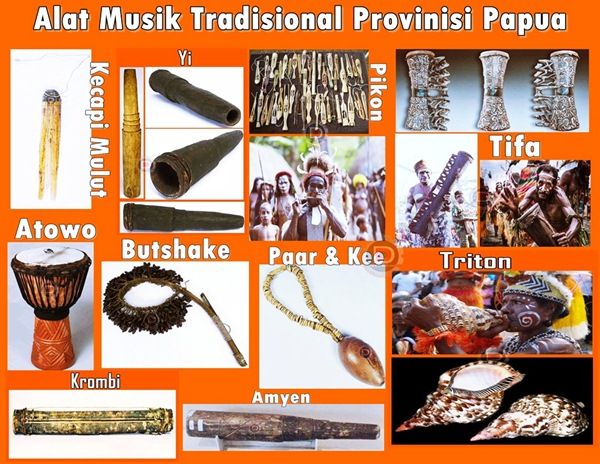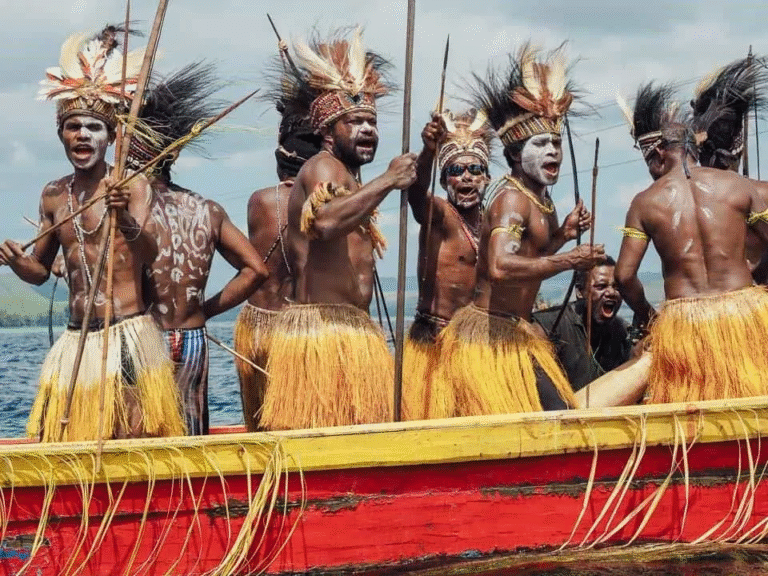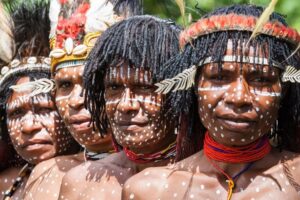The Pulse of Papua’s Soul
Papua, Indonesia’s easternmost region, is a land of mesmerizing landscapes and rich tribal culture. Among the many cultural treasures of Papua lies its deeply-rooted musical tradition, expressed through unique musical instruments that resonate through the forests, mountains, and rivers of the land.
Traditional musical instruments in Papua are more than just tools for entertainment—they are cultural symbols, spiritual connectors, and historical storytellers. This article offers a comprehensive guide to the most iconic instruments of Papua, their roles in tribal life, and their relevance in modern culture.
Chapter 1: Music in Papuan Culture
1.1 Music as a Spiritual Medium
In many Papuan societies, music is not merely sound—it is a spiritual activity. Music is used to:
- Communicate with ancestral spirits.
- Drive away bad omens or illnesses.
- Perform sacred rituals such as births, initiations, and death ceremonies.
The rhythm and tone of these instruments are believed to open pathways between the physical world and the spiritual realm.
1.2 Communal and Social Function
Music strengthens bonds within and between Papuan communities. It accompanies:
- Traditional dances (war dances, welcoming rituals).
- Agricultural festivals and communal feasts.
- Courtship and storytelling.
Music in Papua is communal—it is performed collectively, encouraging participation, not performance.
Chapter 2: Iconic Traditional Instruments of Papua
2.1 Tifa – The King of Papuan Drums
The Tifa is perhaps the most well-known traditional musical instrument from Papua. It is a hand drum made of hollowed wood, with one end covered by animal skin.
- Materials: Hardwood (like merbau or matoa) and skin of deer or lizard.
- Construction: Crafted manually with intricate carvings symbolizing tribal heritage.
- Function: Used in war dances, ceremonies, and to convey urgent messages.
- Sound: Deep, resonant, and rhythmic—often leading group performances.
There are variations of the Tifa across regions:
- Tifa Bass – lower-pitched, used as a base rhythm.
- Tifa Jek – higher-pitched, for accents and variations.
2.2 Pikon – The Bamboo Mouth Harp
The Pikon is a small, bamboo mouth harp native to the Dani people in the Baliem Valley.
- Materials: Slender bamboo reed (approximately 10–15 cm).
- Function: Personal expression; not typically used in groups or rituals.
- Sound: Vibrating, buzzing tone created by inhaling and exhaling while plucking.
Pikon is used to express emotions such as longing or loneliness, often played in solitude.
2.3 Krombi – The Rotan Zither
The Krombi is a string instrument made from palm or rattan fibers.
- Type: Plucked zither.
- Use: Played during quiet evenings, often in rural communities.
- Symbolism: Represents love, courtship, or poetic expression.
2.4 Fuu – The Conch Shell Horn
The Fuu is a wind instrument made from large conch shells or other hard sea mollusks.
- Function: Used to signal war, danger, or announcements across long distances.
- Sound: Loud and echoing—capable of traveling across valleys and hills.
Often used in remote or forested areas, the Fuu serves as an indigenous version of long-distance communication.
2.5 Water Kettle Drum
In some coastal and riverine communities, clay water kettles or pots are used as percussion instruments.
- Technique: Played by tapping wet fingers on the body of the pot.
- Sound: Produces a soft, aquatic echo.
- Context: Used in female-centered music circles or lullabies.
Chapter 3: Crafting the Instruments
3.1 Eco-Friendly and Natural Materials
Most Papuan instruments are made using natural and biodegradable materials sourced from the local environment:
- Wood: Matoa, coconut, or ironwood.
- Skins: Deer, lizard, or other locally hunted animals.
- Fibers: Rattan, palm leaf, and tree bark.
- Shells and Stones: For sound resonance and decoration.
No industrial tools are involved—just hand-carving, drying under the sun, and traditional bonding techniques using tree sap or fibers.
3.2 Ancestral Techniques
The methods used to craft these instruments are passed down orally from one generation to the next. Apprenticeship under master craftsmen is the primary learning path.
- Sacred Carvings: Many instruments include tribal symbols carved into the wood.
- No Nails or Screws: Only organic bindings are used.
Chapter 4: Ceremonial Use and Symbolism
4.1 Sacred Functions
- Tifa: Central to initiation rites, healing rituals, and clan gatherings.
- Fuu: Used during spiritual summoning of rain or ancestral spirits.
- Pikon: Played during grief, remembrance, or isolation.
4.2 Dance and Music Integration
In Papua, music and dance are inseparable. Traditional dances such as:
- Yospan (a joyful dance from Biak and Serui)
- Seka (from the Mimika region)
…are always accompanied by Tifa, chants, and sometimes Krombi or Fuu.
4.3 Gender Roles in Music
While men traditionally play the Tifa and Fuu, instruments like water pot drums or Pikon are often played by women and children.
Chapter 5: Classification of Instruments
Papua’s instruments can be classified based on how they produce sound:
| Type | Instruments | Sound Mechanism |
|---|---|---|
| Membranophones | Tifa, Water Drum | Vibration of stretched skin |
| Aerophones | Fuu, Pikon | Vibration of air inside the instrument |
| Idiophones | Kendi (clay pot) | Body of the instrument vibrates |
| Chordophones | Krombi | String vibration |
Chapter 6: Regional Variations and Tribal Identity
Every tribe in Papua has its own musical identity:
| Tribe | Instruments Used | Cultural Context |
|---|---|---|
| Asmat | Tifa | Warrior ceremonies and initiation |
| Dani | Pikon, Tifa | Mourning and storytelling |
| Sentani | Fuu, Water Drums | Village communication, celebration |
| Biak | Tifa, Bamboo flutes | Welcome dances (Yospan) |
| Mee (Ekari) | Krombi, Rattles | Courtship, farming rituals |
These variations reflect how music adapts to each tribe’s geography, mythology, and social structure.
Chapter 7: From Ritual to Stage – Modern Revivals
7.1 Modernization and Fusion
Contemporary Papuan musicians have begun fusing traditional sounds with genres like:
- Reggae
- Pop
- Gospel
- World music
Artists such as Edo Kondologit and Black Brothers have introduced Tifa rhythms to national and international audiences.
7.2 Festivals and Showcases
Several cultural events celebrate traditional Papuan music:
- Baliem Valley Cultural Festival
- Danau Sentani Festival
- Fakfak Music Expo
- Papua Art Week
These festivals encourage young people to learn and perform with traditional instruments.
Chapter 8: Challenges to Preservation
8.1 Environmental Threats
- Deforestation limits access to quality hardwoods.
- Hunting restrictions reduce availability of animal skins.
8.2 Cultural Displacement
- Youth migration to urban centers has reduced transmission of traditional crafts.
- Western music dominates school curricula.
8.3 Lack of Documentation
Very few instruments are documented in academic or digital archives, risking extinction of lesser-known types.
Chapter 9: Preservation Efforts and Education
9.1 Community Initiatives
- Local elders form music clubs and teaching circles in villages.
- Oral histories and songs are recorded by NGOs.
9.2 Government Programs
- Grants for cultural art programs.
- Inclusion of local instruments in school music classes.
- Support for instrument makers through artisan training.
9.3 Digital Revival
- YouTube tutorials on playing Pikon and Tifa.
- Podcasts and ethnomusicology blogs are raising awareness.
- Virtual reality tours of tribal performances.
Chapter 10: Papuan Instruments in Global Context
10.1 Ethnomusicology Interest
Academic institutions now study Papuan music traditions as part of global heritage preservation.
10.2 Cultural Diplomacy
Tifa and Pikon have been used in cultural showcases in:
- Australia
- Netherlands
- Japan
They are often symbols of Indigenous Indonesian identity in international events.
Conclusion: A Culture in Every Note
Traditional musical instruments from Papua are more than heritage—they are a living, breathing archive of an ancient worldview. Every beat of the Tifa, every whisper of the Pikon, and every blast of the Fuu is a connection to the ancestral soul of the Papuan people.
To preserve these instruments is to preserve the stories, wisdom, and spiritual language of an entire culture. As globalization presses forward, it becomes all the more vital to amplify the voice of the forest—one rhythm at a time.









